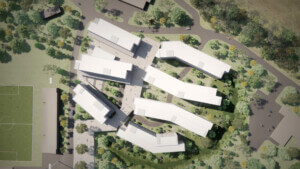A high-performance building prototype which shares energy with a natural-gas-powered hybrid electric vehicle.
A cross-disciplinary team at Oak Ridge National Laboratory (ORNL) have designed an innovative single-room building module to demonstrate new manufacturing and building technology pathways. The research project, named Additive Manufacturing Integrated Energy (AMIE), leverages rapid innovation through additive manufacturing, commonly known as ‘3d printing,’ to connect a natural-gas-powered hybrid electric vehicle to a high-performance building designed to produce, consume, and store renewable energy.
The vehicle and building were developed concurrently as part of the AMIE project. The goal of AMIE was twofold according to Dr. Roderick Jackson, Group Leader of Building Envelope Systems Research and Project Lead for the AMIE project at ORNL: “First, how do we integrate two separate strains of energy: buildings and vehicles; and secondly, how do we use additive manufacturing as a way to create a framework for rapid innovation while not becoming constrained by the resources of today?”
Additive manufacturing contributed to formal expression of the building envelope structure and offered efficiencies in material usage while significantly reducing construction waste. Jackson says the design and manufacturing process became embedded into the ‘rapid innovation’ spirit of the project. “The architects at SOM worked hand in hand with the manufacturing process, sharing the building model with the 3d printers in the same way that the vehicle shares power with building. For example, within the course of less than a week, between the manufacturer, the material supplier, the 3d printers, and the architects, we were able to work together to reduce the print time by more than 40%.” In total, the AMIE project – from research, through design, manufacturing, and assembly – took 9 months.
- Facade Manufacturer
Oak Ridge National Laboratory - Architects
Skidmore, Owings & Merrill LLP - Facade Installer
Clayton Homes (assembly) - Facade Consultants
Oak Ridge National Laboratory (research), Skidmore, Owings & Merrill LLP (design) - Location
Oak Ridge, TN - Date of Completion
September 2015 - System
3d printed atmospherically insulated panels (AIP), post-tensioning rods, photovoltaic (PV) roof panels - Products
20% carbon fiber reinforced ABS plastic
The building incorporates low-cost vacuum insulated panels into an additively manufactured shell, printed in 2’ widths in half ring profiles, assembled at Clayton Homes, the nation’s largest manufactured home builder. The vacuum insulated panels consist of Acrylonitrile butadiene styrene (ABS) with 20% carbon fiber reinforcement, a material which serves as a “starting point” for Jackson and his team: “We wanted to open up the door for people to say ‘what if?’ What if we used a non-traditional material to construct a building? I see this product as a ‘gateway.’ This might not be the final material we’ll end up using to construct buildings in the future. We’ll need to find locally available materials and utilize more cost-saving techniques. But we had to start somewhere. The ABS product will open the door for a conversation.”
The project emerged out of fundamental questions concerning access to, and use of energy. Climate change, an increasing demand for renewable energy sources, and uncertainty in the balance of centralized versus distributed energy resources all impact the grid. In addition, more than 1.3 billion people worldwide have no access to an electric grid, and for an additional billion people, grid access is unreliable.
AMIE will doubly function in the near future as an educational showcase to both the public who will learn of its story, and ORNL researchers who will continue to monitor how energy is generated, used, and stored. Will there be an AMIE 2.0? Jackson responds: “We don’t look at this as a one hit wonder. We really want this research to be the first stone thrown in the water that causes a ripple throughout the disciplines involved. Not only for us, but throughout the world. We want to put this out there so other smart people can look at it and brainstorm. If the end of the next project looks anything like AMIE 1.0, then we’ve missed the boat.”










